Associations of Combined Genetic and Lifestyle Risks With Incident Cardiovascular Disease and Diabetes in the UK Biobank Study
- PMID: 29955826
- PMCID: PMC6143077
- DOI: 10.1001/jamacardio.2018.1717
Associations of Combined Genetic and Lifestyle Risks With Incident Cardiovascular Disease and Diabetes in the UK Biobank Study
Abstract
Importance: Genetic and lifestyle factors both contribute to the risk of developing cardiovascular disease, but whether poor health behaviors are associated with similar increases in risk among individuals with low, intermediate, or high genetic risk is unknown.
Objective: To investigate the association of combined health behaviors and factors within genetic risk groups with coronary artery disease, atrial fibrillation, stroke, hypertension, and type 2 diabetes as well as to investigate the interactions between genetic risk and lifestyle.
Design, setting, and participants: The UK Biobank cohort study includes more than 500 000 participants aged 40 to 70 years who were recruited from 22 assessment centers across the United Kingdom from 2006 to 2010. A total of 339 003 unrelated individuals of white British descent with available genotype and matching genetic data and reported sex were included in this study from the UK Biobank population-based sample. Individuals were included in the analyses of 1 or more new-onset diseases. Data were analyzed from April 2006 to March 2015.
Main outcomes and measures: Risks of new-onset cardiovascular disease and diabetes associated with genetic risk and combined health behaviors and factors. Genetic risk was categorized as low (quintile 1), intermediate (quintiles 2-4), or high (quintile 5). Within each genetic risk group, the risks of incident events associated with ideal, intermediate, or poor combined health behaviors and factors were investigated and compared with low genetic risk and ideal lifestyle.
Results: Of 339 003 individuals, 181 702 (53.6%) were female, and the mean (SD) age was 56.86 (7.99) years. During follow-up, 9771 of 325 133 participants (3.0%) developed coronary artery disease, 7095 of 333 637 (2.1%) developed atrial fibrillation, 3145 of 332 971 (0.9%) developed stroke, 11 358 of 234 651 (4.8%) developed hypertension, and 4379 of 322 014 (1.4%) developed diabetes. Genetic risk and lifestyle were independent predictors of incident events, and there were no interactions for any outcome. Compared with ideal lifestyle in the low genetic risk group, poor lifestyle was associated with a hazard ratio of up to 4.54 (95% CI, 3.72-5.54) for coronary artery disease, 5.41 (95% CI, 4.29-6.81) for atrial fibrillation, 4.68 (95% CI, 3.85-5.69) for hypertension, 2.26 (95% CI, 1.63-3.14) for stroke, and 15.46 (95% CI, 10.82-22.08) for diabetes in the high genetic risk group.
Conclusions and relevance: In this large contemporary population, genetic composition and combined health behaviors and factors had a log-additive effect on the risk of developing cardiovascular disease. The relative effects of poor lifestyle were comparable between genetic risk groups. Behavioral lifestyle changes should be encouraged for all through comprehensive, multifactorial approaches, although high-risk individuals may be selected based on the genetic risk.
Conflict of interest statement
Figures


References
-
- GBD 2013 Mortality and Causes of Death Collaborators Global, regional, and national age-sex specific all-cause and cause-specific mortality for 240 causes of death, 1990-2013: a systematic analysis for the Global Burden of Disease Study 2013. Lancet. 2015;385(9963):117-171. doi:10.1016/S0140-6736(14)61682-2 - DOI - PMC - PubMed
-
- Chiuve SE, McCullough ML, Sacks FM, Rimm EB. Healthy lifestyle factors in the primary prevention of coronary heart disease among men: benefits among users and nonusers of lipid-lowering and antihypertensive medications. Circulation. 2006;114(2):160-167. doi:10.1161/CIRCULATIONAHA.106.621417 - DOI - PubMed
Publication types
MeSH terms
Grants and funding
LinkOut - more resources
Full Text Sources
Other Literature Sources
Medical
Miscellaneous

